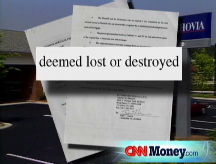Pace of housing rescue slows, as foreclosures rise
Mortgage industry alliance helped 170,000 homeowners avoid foreclosures in May - a monthly pace that slowed even as foreclosures ramped up.
NEW YORK (CNNMoney.com) -- Hope Now, the mortgage industry alliance of lenders, servicers and housing counselors, reported Wednesday that it helped roughly 170,000 homeowners avoid foreclosure in the month of May.
That's down 7% from the 183,000 loan workouts it reported for April. The group estimates that its members have helped keep 1.7 million homeowners out of foreclosure since July 2007.
The reason for the dip "wasn't a slowdown in efforts," said a Hope Now spokesman. "We expect all of this to catch up in June and [to post] an increase over May numbers in June," he said.
The proportion of repayment plans versus true loan modifications stayed about the same from April to May; roughly 60% of the workouts were repayment plans, while 40% were modifications.
Repayment plans are considered most effective for borrowers experiencing a temporary financial set back - such as a layoff - in which they fall behind on their mortgage payments.
Housing advocates contend that repayment plans are typically not sufficient to keep today's subprime borrowers in their homes because they don't reduce the borrower's delinquent debt - they simply give borrowers more time to repay their outstanding debt on top of their regular mortgage payments.
"They don't help anyone if the underlying loan is bad," said Kathleen Day, a spokesman for the Center for Responsible Lending.
Indeed, not everyone is happy with the progress that Hope Now has made against the flood of foreclosures, which are growing at an alarming rate.
While the number of homeowners that Hope Now helped dipped 7% from April to May, the number of homes lost to foreclosure during that same period jumped 35% to 73,000, according to RealtyTrac. Foreclosure filings were up 7% in the same period. That's a trend foreclosure experts expect will continue for the next 18 months.
In a separate survey of subprime adjustable-rate mortgages, Hope Now reported that of the 718,000 loans scheduled to reset between January and May, 5.3% - or 37,700 - had been modified, meaning the contractual terms of the loan were changed. Of those modified loans, 64% of them were modified for 5 years or longer.
It's not clear from the Hope Now data what types of modifications these were, but FDIC Chairman Sheila Bair and housing advocates have called for lenders to freeze the introductory interest rate on subprime ARMs for at least 5 years.
Hope Now also reported in that survey that 45% - or 323,000 of the subprime loans slated to reset - were paid in full either when the homeowner refinanced the loan or sold the property.
However, the majority of subprime loans are scheduled to reset this summer and in the fall.
Consumer advocates contend that Hope Now members don't provide enough details about their loan workouts for third parties to gauge how effective those workouts will be in keeping borrowers in their homes for the long run.
To complicate matters, loan workout data are being reported in an inconsistent fashion by various groups. Data from the Office of the Comptroller of the Currency, which regulates national banks, for example, reported 167,000 loan workouts in the first quarter of 2008. Of those, only 36,000 were modifications.
But Hope Now says it completed 502,000 loan workouts during that same period, of which 179,500 were loan modifications. That's 5 times the number of modifications reported by the OCC.
One factor that may account for some of the difference: Hope Now collects information from a larger cross-section of the industry than the OCC does. Additionally, Hope Now and the OCC may have different ideas of what constitutes a loan modification -- there is no industry standard definition. The OCC asserts that its analysis has been more precise than any other study to date.
"HOPE NOW is confident that the information it is receiving from its members and the methods being used to compile its monthly reports are reliable," said Faith Schwartz, the group's executive director, in a statement.
The group said it is working with the OCC and the Office of Thrift Supervision, which regulates savings and loan institutions, to develop "a more uniform reporting framework and set of data definitions."
Wherever the real number of loan modifications lies, consumer advocates and state banking regulators agree that the industry is overwhelmed and can't keep up with the growing number of delinquent loans.
"A lot of delinquent homeowners aren't on track to get a modification," said Mark Pearce, the deputy commissioner of banks in North Carolina, and an active member in a state foreclosure-prevention group that did its own analysis of loan workouts.
"We think the system is overburdened and has too many homeowners who've fallen through the cracks." ![]()



